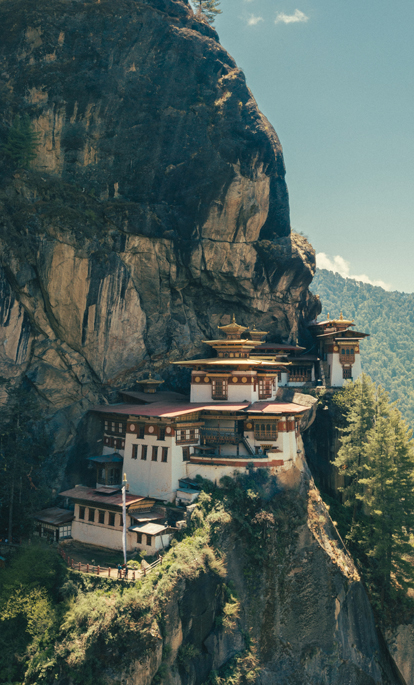Bhutan is open all seasons. For example, for a good view of the mountains the dry season is ideal, from November to April (although rainfall can still be fairly high in some months). In general, the Bhutan climate varies considerably with elevation. A subtropical climate prevails in the southern Great Plains with warm, humid summers and mild winters around 15°C. The east-central hills and valleys are drier and more temperate than in the west. In the western valleys, temperatures are more severe and snow occasionally occurs in winter. In the north of the country, there's a rather difficult alpine climate, especially towards the highest peaks, constantly under snow. It should be noted that the north constitutes the territory of the Great Himalayas and other peaks rising to more than 22,965ft. They are only inhabited by the Bjop (pastoralists and nomadic herders), accustomed to this type of extreme conditions. In other words, you only get there after intense training!
Main areas to visit: Western Valley (e.g. capital Thimphu, Paro, Punakha), Southern Bhutan (e.g. Gelephu, Phuentsholing), eastern valleys (e.g. Sakteng Park)
January: heading south
Just like the western valley, the localities of this area are quite cold in January with 5°C on average but plenty of sunshine. The eastern valleys are not much warmer with an average temperature of 4 to 6°C. The southern zone is, on the other hand, much more summery with an average temperature of 24°C. In this area, you are strongly advised to take the road between Phuentsholing and Thimphu, moving from tropical vegetation to conifers in a single journey, all wrapped in a blanket of mist, giving the place an almost mystical feel.
February: a few degrees higher in the valleys
It gets a few degrees warmer in the western and eastern valleys (7°C on average) with the sun still present. Well wrapped-up, you can stroll through the streets of the capital, including Norzim Lam, for souvenirs in shops selling fabrics, books, mystical masks and other objects of all kinds. In the south, the weather is always more summery with 27°C and beautiful bright days. Note: celebrate Losar, the Tibetan new year, in February. The Bhutanese paint their house and host numerous archery and dart tournaments.
March: slightly heavier rainfall
Rain is fairly moderate but can fall on certain days. The southern zone begins to warm considerably with an average temperature of 31°C. The valleys, in turn, are around 8-10 °C (10 to the east and 8 to the west), heralding the start of the warm season.
April: humidity increases.
As usual, the eastern valleys warm up a little before their western neighbours, with an average temperature of 14°C. On the other hand, the rains intensify, particularly in the west with about twenty days of rainfall. As the humidity increases, visibility on the peaks is slightly worse than in the previous month. The south is also fairly humid but has summer temperatures with an average temperature of 31°C. With about 18 rainy days a month, it is possible to check the weather forecast before planning a trip. It should be noted that trekking is recommended during this period because the mountains are covered with rhododendrons in bloom. But you'll need rainwear.
It is worth noting that this is when the Tsechu festival in Paro is celebrated. In the itinerary: ritual dances and a huge thangka (religious image) parade.
May: rainy season approaching
The valleys are close to spring temperatures with an average temperature of 13°C to 15°C. However, as the wet season approaches, rainfall increases throughout the territory, particularly in the south, which is subject to a subtropical climate. In general, the days fluctuate between precipitation and lightening. Therefore, a raincoat is an essential for this visit.
June: the monsoon turns up
Wherever you are in Bhutan in June, you'll get rained on. Especially as monsoon clouds can sometimes cause cancellations at Paro Airport and roads are sometimes flooded. The only consolation is that wild flowers cover the high valleys during this time of year.
July: Bhutan is waterlogged
In the middle of the monsoon, July is very rainy and cloudy. The south is especially hot and humid, which makes this time of year quiet with tourists. Be aware that in July the country experiences the highest rainfall rate in the entire Himalayas. We'd recommend that you start your journey at the end of September to avoid the rainy season.
August: slightly drier with a drop in rainfall
Rainfall declines just slightly in August, but is still high enough to disrupt your visit as it can rain heavily almost every day. On the flip side, it means that the vegetation is very lush at this time of year and mushrooms, mangoes and avocados grow everywhere.
September: opt for the end of the month
The first half of September is still rather rainy, while the last few weeks enjoy a beautiful blue sky and several big festivals take plac














